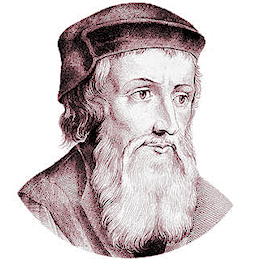Textus Receptus Bibles
John Wycliffe Bible 1382
| 4:1 | Therfor Booz stiede to the yate, and sat there; and whanne he hadde seyn the kynesman passe forth, of whom the word was had, Booz seide to hym, Bowe thou a litil, and sitte here; and he clepide hym bi his name. And he turnede, and sat. |
| 4:2 | Forsothe Booz took ten `men of the eldere men of the citee, and seide to hem, Sitte ye here. |
| 4:3 | And while thei saten, Booz spak to the kynesman, Noemy, that turnede ayen fro the cuntrey of Moab, seelde the part of the feeld of oure brother Elymelech, |
| 4:4 | which thing Y wolde that thou here; and Y wolde seie to thee bifor alle `men syttynge and grettere in birthe of my puple. If thou wolt haue in possessioun the feeld bi riyt of nyy kyn, bye thou, and `haue thou in possessioun; sotheli if it displesith thee, schewe thou this same thing to me, that Y wyte what Y `owe to do; for noon is niy in kyn, outakun thee which art the formere, and outakun me which am the secunde. And he answeride, Y schal bie the feeld. |
| 4:5 | To whom Booz seide, Whanne thou hast bouyte the feeld of the `hond of the womman, thou owist `to take also Ruth of Moab, that was the wijf of the deed man, that thou reise the name of thi kynesman in his eritage. |
| 4:6 | Which answeride, Y forsake the ryyt of nyy kyn; for Y owe not to do awei the eritage of my meynee; vse thou my priuelegie, which priuelegie Y knowleche me to wante gladli. |
| 4:7 | Forsothe this was the custom bi eld tyme in Israel among kynesmen, that if a man yaf his riyt to anothir man, that the grauntyng were stidefast, the man vnlaase his scho, and yaf to his kynesman; this was the witnessyng of the yift in Israel. |
| 4:8 | Therfor Booz seide to his kynesman, Take the scho fro thee; `which scho he vnlaside anoon fro his foot. |
| 4:9 | And Booz seide to the grettere men in birthe and to al the puple, Ye ben witnessis to dai, that Y haue take in possessioun alle thingis that weren of Elymelech, and of Chelion, and of Maalon, bi the yifte of Noemy; |
| 4:10 | and that Y haue take in to wedlok Ruth of Moab, the wijf of Maalon, that Y reise the name of the deed man in his erytage; lest his name be doon awey fro his meynee and britheren and puple. Ye, he seide, ben witnessis of this thing. |
| 4:11 | Al the puple, that was in the yate, answeride, and the grettere men in birthe answeriden, We ben witnessis; the Lord make this womman, that entrith in to thin hows, as Rachel and Lia, that bildiden the hows of Israel, that sche be ensaumple of vertu in Effrata, and haue a solempne name in Bethleem; |
| 4:12 | and thin hows be maad as the hows of Fares, whom Thamar childide to Judas, of the seed which the Lord schal yyue to thee of this damesel. |
| 4:13 | Therfor Booz took Ruth, and took hir to wijf; and he entride to hir, and the Lord yaf to hir, that sche conseyuede, `and childide a sone. |
| 4:14 | And wymmen seiden to Noemy, Blessid be the Lord, which `suffride not, that an eir failide to thi meynee, and his name were clepid in Israel; |
| 4:15 | and that thou haue `a man, that schal coumforte thi soule, and nursche elde age. For a child is borun of thi douytir in lawe, `which child schal loue thee, and he is myche betere to thee, than if thou haddist seuene sones. |
| 4:16 | And Noemy puttide the child resseyued in hir bosum; and sche dide the office of a nurische, and of a berere. |
| 4:17 | Forsothe wymmen neiyboris thankiden hir, and seiden, A sone is borun to Noemy, and clepide his name Obeth. This is the fadir of Ysay, fadir of Dauid. |
| 4:18 | These ben the generaciouns of Fares; Fares gendride Esrom; |
| 4:19 | Esrom gendride Aram; Aram gendride Amynadab; |
| 4:20 | Amynadab gendride Naason; Naason gendride Salmon; Salmon gendride Booz; |
| 4:21 | Booz gendride Obeth; |
| 4:22 | Obeth gendride Isay; Isay gendride Dauid the kyng. |

John Wycliffe Bible 1382
The Wycliffe Bible is the only Bible here that was not translated from the Textus Receptus. Its inclusion here is for the Bible's historic value and for comparison in the English language.
John Wycliffe, an Oxford professor produced the first hand-written English language Bible manuscripts in the 1380's. While it is doubtful Wycliffe himself translated the versions that bear his name, he certainly can be considered the driving force behind the project. He strongly believed in having the scriptures available to the people.
Wycliffe, was well-known throughout Europe for his opposition to the teaching of the organized Church, which he believed to be contrary to the Bible. With the help of his followers (called Lollards), Wycliffe produced dozens of English language manuscript copies of the scriptures. They were translated out of the Latin Vulgate, which was the only source text available to Wycliffe. The Pope was so infuriated by his teachings and his translation of the Bible into English, that 44 years after Wycliffe died, he ordered the bones to be dug-up, crushed, and scattered in the river.